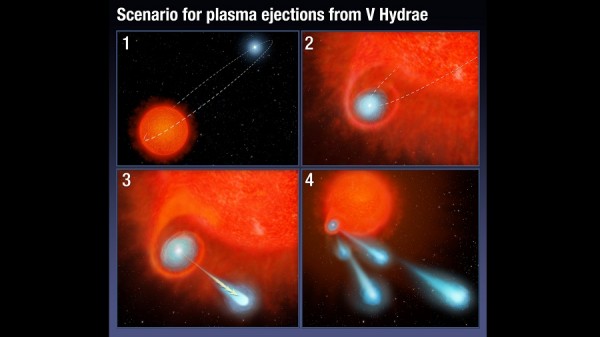By Ana Verayo, | October 08, 2016

This four-panel graphic illustrates how the binary-star system V Hydrae is launching balls of plasma into space.
Plasma "cannonballs" were seen shooting from a red giant star some 1,200 light years away in recent images captured by the NASA's Hubble Space Telescope of the V Hydrae system. Astronomers believe that these blobs of plasma are linked to the formation of planetary nebulae.
Like Us on Facebook
These cosmic cannonballs are so massive that they are about twice the size of Mars and traveling at incredible speeds comparable to traveling from Earth to the moon in 30 minutes. The V Hydrae galaxy ejects these energy blobs every 8.5 years. Scientists estimate that this system has been firing plasma blobs for at least four centuries.
These planetary nebulae appear as swirls of glowing gas that enshroud dying stars such as red giants. They do not appear the same as they possess different shapes, colors, and sizes.
It is still unclear how these plasma energy blobs are being spewed by this red giant star. Astronomers have suggested that a companion star is the source.
According to astronomer Raghvendra Sahai of NASA's Jet Propulsion Laboratory, this is the first time that scientists have been able to observe this object in action, suggesting that these gaseous blobs are produced during the last stages of a star's lifespan.
Researchers simulated this cosmic phenomenon with a model to explain these plasma blobs. They suggest that an accretion disk surrounding the red giant's companion star is apparently the main source.
Sahai explained that normally, red giants do not possess accretion disks, but they most likely have companion stars that are also low in mass since they evolve more slowly than regular stars.
Since astronomers believe that this cannonball phenomenon has already been existing for hundreds of years, they suggest that the stellar companion and the accretion disk of the red giant is in a stable condition, since most companion stars are swallowed by their red giant star due to powerful gravitational forces.
Sahai adds that V Hydrae's companion star will continue to decay, as it is now losing energy from this frictional interaction.
This study has been published in the Astrophysical Journal.
-
Use of Coronavirus Pandemic Drones Raises Privacy Concerns: Drones Spread Fear, Local Officials Say

-
Coronavirus Hampers The Delivery Of Lockheed Martin F-35 Stealth Fighters For 2020

-
Instagram Speeds Up Plans to Add Account Memorialization Feature Due to COVID-19 Deaths

-
NASA: Perseverance Plans to Bring 'Mars Rock' to Earth in 2031

-
600 Dead And 3,000 In The Hospital as Iranians Believed Drinking High-Concentrations of Alcohol Can Cure The Coronavirus

-
600 Dead And 3,000 In The Hospital as Iranians Believed Drinking High-Concentrations of Alcohol Can Cure The Coronavirus

-
COVID-19: Doctors, Nurses Use Virtual Reality to Learn New Skills in Treating Coronavirus Patients







